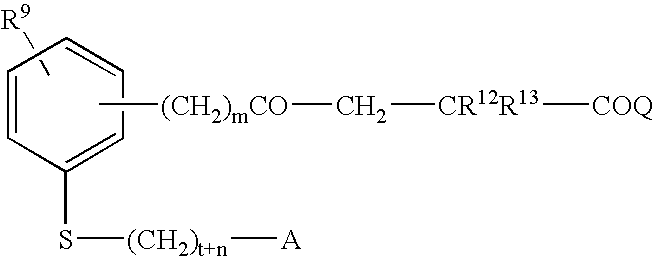Compounds for the Treatment of Metabolic Disorders
a metabolic disorder and compound technology, applied in the field of compound therapy for metabolic disorders, can solve the problems of diabetes mellitus being a major cause of morbidity and mortality, debilitating complications, and prone to coronary artery diseas
- Summary
- Abstract
- Description
- Claims
- Application Information
AI Technical Summary
Benefits of technology
Problems solved by technology
Method used
Image
Examples
example 1
4-(4-[(2,6-Dimethylbenzyl)-thio]-phenyl)4oxobutyric acid
[0107]
Step A: Preparation of 4′-Mercaptoacetophenone:
[0108] Synthesized according to procedure as described in WO 94 / 17054.
Step B: Preparation of 2,6-Dimethylbenzyl chloride:
[0109] To a stirred solution of 2,6-Dimethylbenzyl alcohol (9.94 g, 73 mmol) was added thionyl chloride (81.55 g, 685 mmol) at room temperature. The reaction mixture was stirred for 6 hours, concentrated under reduced pressure and used without further purification.
Step C: Preparation of 4-[(2,6-Dimethylbenzyl)-thio]acetophenone:
[0110] To a stirred solution of NaH (60% in oil, 1.7 g, 51.1 mmol) in dry ThF (20 ml) and dry DMF (5 ml) was added 4′-Mercaptoacetophenone (Step A, 5.18 g, 34 mmol) followed by the dropwise addition of 2,6-Dimethylbenzyl chloride (Step B, 4.39 g, 28.4 mmol) diluted in dry THF (5 ml). The reaction mixture was stirred at room temperature for 12 hours, quenched slowly with water at 0° C. The organic layer was extracted with ethyl ...
example 2
Antidiabetic effects of Compound CS in db / db Mice.
[0116] C57BL / Ksola (db / db) mice have a defect in leptin signaling, leading to hyperphagia, obesity, hypertriglyceridemia, and diabetes. Moreover, unlike ob / ob mice on a C57BL / 6J background, db / db mice on a C57BLKS background undergo failure of their insulin- producing pancreatic islet cells, resulting in progression from hyperinsulinemia (associated with peripheral insulin resistance) to hypoinsulinemic diabetes.
[0117] Male obese (db / db homozygote) C57BL / Ksola mice approximately 8 weeks of age, were obtained from Jackson Labs (Bar Harbor, Me.) and sorted into groups of 7 animals each animals such that the body weights (40-45 g) and serum glucose levels (≧300 mg / dl in fed state) were similar between groups. A minimum of 7 days was allowed for adaptation after arrival. All animals were maintained under controlled temperature (23° C.), relative humidity (50±5%) and light (7:00-19:00), and allowed free access to standard chow (Formulab...
PUM
| Property | Measurement | Unit |
|---|---|---|
| temperatures | aaaaa | aaaaa |
| temperature | aaaaa | aaaaa |
| weight | aaaaa | aaaaa |
Abstract
Description
Claims
Application Information
 Login to View More
Login to View More - R&D
- Intellectual Property
- Life Sciences
- Materials
- Tech Scout
- Unparalleled Data Quality
- Higher Quality Content
- 60% Fewer Hallucinations
Browse by: Latest US Patents, China's latest patents, Technical Efficacy Thesaurus, Application Domain, Technology Topic, Popular Technical Reports.
© 2025 PatSnap. All rights reserved.Legal|Privacy policy|Modern Slavery Act Transparency Statement|Sitemap|About US| Contact US: help@patsnap.com



